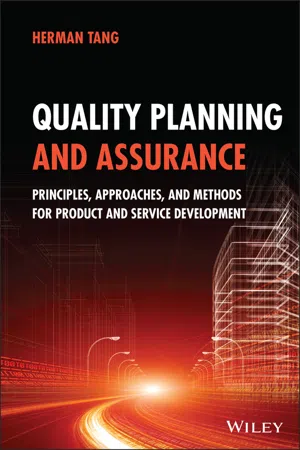
Quality Planning and Assurance
Principles, Approaches, and Methods for Product and Service Development
- English
- ePUB (mobile friendly)
- Available on iOS & Android
Quality Planning and Assurance
Principles, Approaches, and Methods for Product and Service Development
About this book
QUALITY PLANNING AND ASSURANCE
Discover the most crucial aspects of quality systems planning critical to manufacturing and service success
In Quality Planning and Assurance: Principles, Approaches, and Methods for Product and Service Development, accomplished engineer Dr. Herman Tang delivers an incisive presentation of the principles of quality systems planning.
The book begins with an introduction to the meaning of the word "quality" before moving on to review the principles of quality strategy and policy management. The author then offers a detailed discussion of customer needs and the corresponding quality planning tasks in design phases, as well as a treatment of the design processes necessary to ensure product or service quality.
Readers will enjoy explorations of advanced topics related to proactive approaches to quality management, like failure modes and effects analysis (FMEA). They???ll discover discussions of issues like supplier quality management and the key processes associated with quality planning and execution.
The book also includes:
- A thorough introduction to quality planning, including definitions, discussions of quality system, and an overview of the planning process
- A comprehensive exploration of strategic planning development, including strategic management, risk management and analysis, and pull and push strategies
- Practical discussions of customer-centric planning, including customer-oriented design, quality function deployment, and affective engineering
- In-depth examinations of quality assurance by design, including the design review process, design verification and validation, and concurrent engineering
Perfect for senior undergraduate and graduate students in technology and management programs, Quality Planning and Assurance will also earn a place in the libraries of managers and technical specialists in a wide range of fields, including quality management.
Frequently asked questions
- Essential is ideal for learners and professionals who enjoy exploring a wide range of subjects. Access the Essential Library with 800,000+ trusted titles and best-sellers across business, personal growth, and the humanities. Includes unlimited reading time and Standard Read Aloud voice.
- Complete: Perfect for advanced learners and researchers needing full, unrestricted access. Unlock 1.4M+ books across hundreds of subjects, including academic and specialized titles. The Complete Plan also includes advanced features like Premium Read Aloud and Research Assistant.
Please note we cannot support devices running on iOS 13 and Android 7 or earlier. Learn more about using the app.
Information
1
Introduction to Quality Planning
1.1 Quality Definitions
1.1.1 Meaning of Quality
Definition of Quality
- Quality is customer (or end-user) oriented.
- Quality is a distinctive characteristic or degree of excellence of something.
- Quality is adherence to specifications (or standards/regulations) by a product or service.
- Quality is a summary description of multiple dimensions and aspects.
Measurement of Quality
- Of a specific status or result from a product or service
- Of a process or system of processes involved with a product or service

Table of contents
- Cover
- Title page
- Copyright
- Forewords
- Foreword
- Preface
- Acknowledgments
- About the Author
- 1 Introduction to Quality Planning
- 2 Strategy Development for Quality
- 3 Customer–centric Planning
- 4 Quality Assurance by Design
- 5 Proactive Approaches: Failure Modes and Effects Analysis and Control Plan
- 6 Supplier Quality Management and Production Part Approval Process
- 7 Special Analyses and Processes
- 8 Quality Management Tools